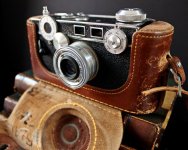@
WayneF This was just about exactly what my (really my dad's) C3 looked like with the nice leather case. I really wish I still had it, but my sister got it and
THREW IT OUT when it stopped working. Boy, I ran a LOT of rolls of film threw that camera!
View attachment 168638
Sorry for a delay, I took a day off.

Arguably a real beauty after all.

A very pleasant reminder of yesterday. The C3 certainly was a popular classic, and was actually made in the USA back in the day. It ought be a collectors item, but I think not rare, too popular to carry a price now. Wikipedia says 2 million C3 cameras over about 25 years. Not expensive relatively, but better than cheap ones. Many better cameras then were German, until Japan started to come on strong with some quality by about 1960. Not sure who won the war, our US manufacturing capability is gone now.
I bet the youngsters really don't have much idea about using cameras of that era. First of course we had to individually set both aperture and shutter speed (true manual mode

), either by Sunny 16 or by guess, or affordable hand held selenium meters were ultimately being introduced towards the end. We didn't see results for at least hours, or probably days or weeks. Flash bulbs had guide numbers, with only one level. Most people just used the flash bulb and hoped the lab could correct it. Then we had to adjust the lens focus by aligning the two superimposed rangefinder images. I suppose it was accurate, I never heard much complaint otherwise, but the linkage certainly had to be built right. C3 lenses were interchangeable, but few people bothered, because rangefinders were a framing problem except with the normal lens - lens and viewfinder saw very different size images, which were also slightly offset due to parallax. SLR cameras had that strong advantage (interchangeable lenses), with the split image finders which we again aligned manually, but which relied on the viewfinder and film paths being identical path distance.
The good old days back then, in many respects.

